Gardeners appreciate gooseberries for abundant crops, easy care, low soil fertility and warmth, delicious dietary berries.
For the high content of vitamins and minerals it is called the northern grapes. With proper care, the shrub fruits up to fifteen, in particularly favorable conditions - up to thirty years. Productivity reaches twenty five kilograms from one plant.
In this article we will just talk about how to care for gooseberries in August and September, as well as learn how to grow bushes in the country
Table of contents
The main types of work for the care of gooseberries in summer and autumn
Care for the prickly berry during the season includes:
- pruning and thinning;
- watering;
- weeding;
- protection from pests and diseases;
- top dressing;
- loosening;
- mulching.
To begin work with the choice of landing site. Preferred solar, protected from the wind areas. The fertility of the soil gooseberry is not demanding. Does not transfer overmoistened lowlands. You should choose a place where groundwater does not come closer than one, and preferably one and a half meters to the surface.
Excessively light, heavy, acidified soils will have to be cultivated. When planting it is necessary to fertilize, remove dry and damaged roots, shorten the shoots on the seedling.To deepen a root neck approximately on three - five centimeters below, than the bush grew in nursery. Planted better in the fall before the onset of frost. Autumn plantings take root better than spring.
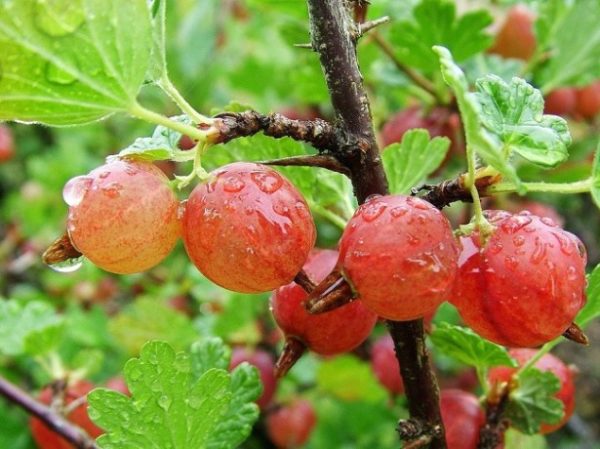
Pruning and thinning gooseberries in the country
The first pruning is made immediately after planting the seedling. The shoots are shortened, on each save two to three buds. A year later, some of them are formed of strong, ready-for-wintering yearlings.
Sanitary pruning is done regularly. Remove the broken, diseased, damaged creeping, twisted shoots. In the fall, spend forming trimming.
Some varieties of gooseberry, as well as specimens growing in particularly favorable conditions, provide abundant basal growth. There is a danger of thickening. In these cases, the excess shoots are carefully removed.
Watering
Gooseberry does not tolerate stagnant moisture in the soil. Therefore, it cannot be planted in the lowlands, where the spring lasts long, or the groundwater is high. However, the berry needs regular and abundant watering. In the first year of the plant’s life, such a measure ensures the active growth of strong shoots.
In the future, a sufficient amount of moisture contributes to a greater yield of large tasty berries. Under the young bushes need to pour out ten to twenty liters of water each week, for adults - twice as much.
If it is not possible to water the gooseberries every few days, you can apply a different scheme. Abundantly shed after flowering in the period of growth of berries and shoots, then - when the ovary appears, in the fall to produce water recharge to create conditions for the growth of the root system and prepare the plants for wintering. Each time, pour at least five buckets of water under the bush.
To avoid soil erosion and stagnation of fluid at the root collar, a groove is arranged around the perimeter of the crown. The drip method has proven itself well: fluid consumption is reduced, efficiency is increased. Significantly reduce the frequency of irrigation helps mulch.
Gooseberry tolerates short dry periods. But prolonged drying will reduce the number of berries, it happens not for one season. Therefore, it is important to maintain a soil moisture level of at least 70 percent.
During the ripening of the fruit should be watered evenly and regularly. Otherwise, the berries can crack.
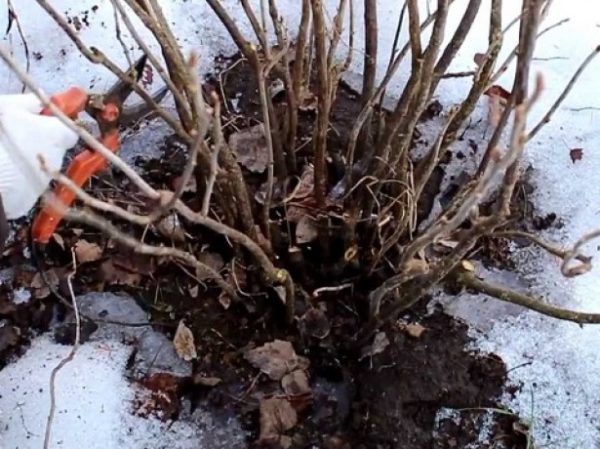
Weeding and fertilizer
The absence of weeds is an important condition for the cultivation of gooseberries. You need to remove all the grass under the bushes and between the rows, it is better to manually, especially carefully - wheat grass creeping. The task is complicated by the spinousness of most varieties and the fact that the fibrous root growing in breadth shallow from the surface of the earth is easily damaged.
Mulching, among others, helps to solve this problem. Some gardeners use tree trunks from roofing material or made industrially from modern materials. Such shelters do not let the light through, and the growth of grass under them is oppressed.
It is not recommended to use herbicides on private plots for weed control in plantings of berries. There is a risk of chemical accumulation in the soil under berry bushes with regular treatment for several years.
Pest and disease protection
During the growing season, it is necessary regularly (ideally daily) to carefully inspect the gooseberries in order to notice the first signs of the appearance of pests or diseases. Upon detection, immediate action is required to suppress the lesion.
More often than other harmful insects gooseberries inhabit:
- aphid;
- kidney mite;
- glass bowl;
- sawfly
- ognevka.
To combat them use:
- copper sulphate;
- karbofos solution;
- biological insecticides.
Use folk remedies:
- sprayed plants with infusion of wood ash (pour one kilogram of ash with three liters of boiling water and draw for 24 hours);
- before the end of snow melting and until the appearance of green kidney cones, water the bushes with boiling water from a watering can once;
- Planted next to the bushes (and a half - two meters) plants that repel pests: garlic, dill, marigold, chrysanthemum.
It is useful to add a small amount of soap solution to these preparations and to the ash extract.
If, despite the measures taken, the pests have not disappeared, you can repeat the treatment after flowering (except boiling water).
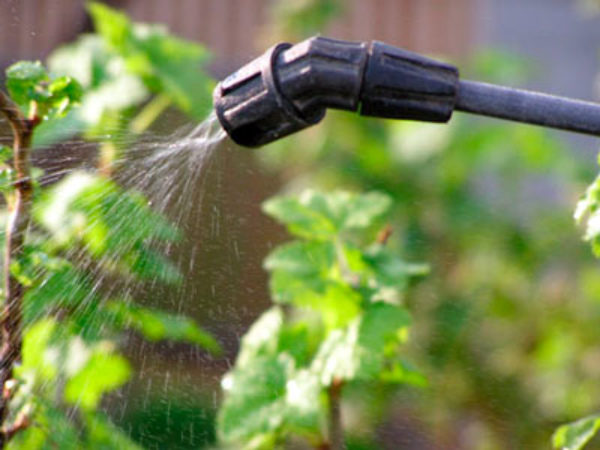
Gooseberry Diseases and Treatments
Sphereoteka (powdery mildew). Fungus. Processing should begin immediately after the discovery of the first signs - white bloom. Apply: Bordeaux mixture, sodium bicarbonate solution (5 g per 1 l of water), ash infusion or soda ash solution (50 g per 10 l of water). To prevent problems in the spring and closer to the fall sprayed with the drug "Cantan" or analogues. Immediately after flowering, twice, with an interval of eight to ten days, treated with infusion of cow manure.
Septoriosis (white spot). First, brown plaques appear. Affected leaves must be removed and burned immediately. Treat bushes with boric acid solution. To prevent loosening, introduce copper sulfate into the soil.
Glass rust. The first symptoms are orange spots on the leaves. For treatment process after flowering Bordeaux liquid. For prevention in the spring to shed the soil with a solution of potassium permanganate.
Gooseberry anthracnose. Brown-brown tubercles on the leaves. Treatment: spray the bush with a solution of copper sulfate, the ground under it - with a solution of boric acid, Bordeaux or zinc liquid.
For mechanical protection, tree-trunk circles, made, for example, of roofing felt, have proven themselves well. Stacked under the shrub, they impede the access of pests from the soil.
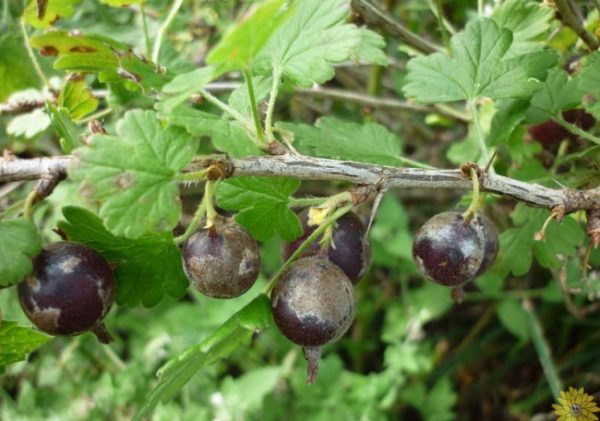
How to feed gooseberries?
Berry responsive to systematic, but not excessive feeding. In early spring, nitrogen fertilizers are applied in the form of a solution: 50 grams of ammonium nitrate or urea at the rate of 20–30 g per square meter of planting (approximately 60 g per bush).
The pellets are scattered under the bushes in the snow at the very beginning of melting: nutrients, gradually dissolving, are delivered to the roots with melt water.
Potash, phosphate and organic fertilizers are left for autumn.
Loosening
The surface of the earth must be kept loose. Under the crown, periodically gently loosen to a depth of three to five cm, if necessary, at the same time closing up fertilizers and removing weeds.
Mulching
As mulch use mature compost, humus, dry fallen leaves and grass, rotted peat. Cover the podkustov space with a layer of at least 5 cm. Mulch retains moisture, well structures the soil, stimulates an increase in the amount of organic matter, slows the growth of weeds.
How to care for gooseberries after harvest in August and September
Late summer and autumn laid the foundation for plant health and the harvest of the next season. It is necessary to start immediately after picking the berries, and before the onset of the frost to be in time:
- produce thorough weeding under the bushes, remove weeds, fallen leaves and other vegetation residues;
- Abundantly shed every plant;
- feed;
- dig the ground under bushes and between the rows,
- process shrubs means of protection against diseases and pests;
- cut off the old and weakened branches;
- grumble;
- prepare for overwintering.
Soil cleaning
Immediately after removing the fruits, the gooseberries are carefully weeded, removing grass, weed roots, sticks, twigs and other debris from under it. Fallen leaves are immediately burned in order to avoid overwintering of pathogens in them.
Create moisture reserve
About a month before the arrival of frosts, it is important to produce the so-called water recharge irrigation. At each bush will need at least 50 - 60 liters of water, you can pour in two - three stages.The liquid supply will allow the gooseberry to endure cold weather, resist diseases, and form fruit and vegetative buds.
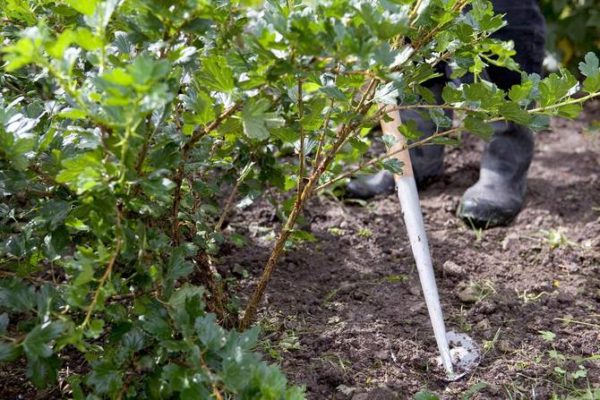
Autumn feeding
At the end of the harvest, the gooseberries are fed with superphosphate (up to 50g) and potassium chloride (up to 30g). As a potash fertilizer, you can add one liter of ash. Phosphate fertilizers affect the increase in yield. Potash provide drought resistance, frost resistance, increase immunity to fungal diseases.
In the fall, every bush is “fed” with organic fertilizers:
- humus - one bucket;
- chicken litter (1 to 10) or mullein (1 to 5).
On acidic soils, it is required to add lime, chalk or dolomite flour.
Reference. Fertilizer rates should be increased if the soil in the area is neutral or slightly alkaline.
Autumn processing gooseberry
Autumn pruning
Every year at the end of autumn (before the first frosts), they form and rejuvenate pruning. In one-year plants leave three to five strong developed shoots. Choose well located to lay the correct base of the bush. The rest is cut flush with the soil surface. The next three to four years also leave some of the most successful gains, the rest are removed. A properly formed adult plant consists of five to six trunks of each age (one-year, two-year, and so on).
The greatest number of fruits, as a rule, ripens on two to four-year branches. Anything older than five or six years, leave no sense. Distinguish between "oldies" is easy, they are the darkest and largest. Four to five of the strongest annual basal shoots are retained, about the same number of old frame branches and all diseased are removed. Pruning is carried out as close to the ground as possible. Powerful developed branches on old branches can be saved by cutting only the unusable parts.
Gooseberry bushes are thinned if necessary. Condensed less fruitful: too little light penetrates inside, there are no ovaries, a fungus settles. On well-lit branches actively form and develop fruit buds.
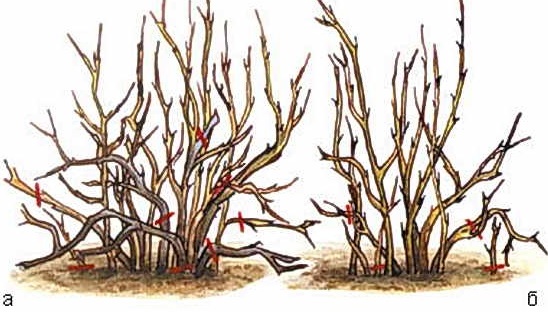
Digging open ground
Prior to the establishment of sub-zero temperatures, the soil around the gooseberry should be carefully but carefully loosened. Depending on the density of the soil, it is “flooded” with pitchforks or digging with a shovel. Over the entire area of the berry, the soil is dug up by 18 - 20 cm, under the canopy - by 5-6 cm. Autumn fertilizers are also being buried at the same time. Small lumps of earth can not break.
Before winter digging it is not worth neglecting also because it makes it difficult for the pests and causative agents of berry diseases to hibernate in the soil.And the cultivation in the open ground gooseberry next year becomes easier.
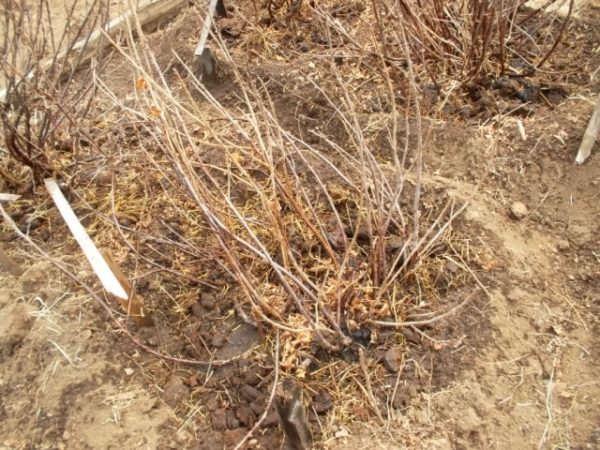
Disease prevention: how to treat?
When there are no berries left on the bushes, you can take intensive measures to rescue diseased plants, treat them with appropriate fungicides and insecticides. If the lesions are of irreversible scale, the bush will have to be sacrificed, dig it up and burn it. This loss may allow you to save the remaining instances.
In the autumn, preventive procedures for the prevention of diseases and the spread of pests are necessarily carried out. For this, the shrub and the soil under it are carefully treated with Bordeaux mixture or copper sulphate and Inta-vir solution.
How to prepare the bushes for winter and how to fertilize?
As a rule, adult berries bear winter well. Young, weakened plants, representatives of heat-loving varieties and gooseberries, “living” in cold climatic zones, need help.
After all the planting works in the autumn, the grounding should be done: cover the surface of the earth under bushes and in between rows with a 10-centimeter layer of natural protective material - rotted manure,ripened humus, peat, sawdust, small branches. In winter, under such a litter is kept warm, organic processes continue. In the northern regions, you can additionally pour dry earth to the base of the bush, cover the embankment with agrospanum. With the onset of positive temperatures, it is necessary to remove the entire insulating layer so that the soil warms up in time and the bush leaves the state of rest.
In the zones of severe winter (in the North in Siberia, in the Urals), as well as in gardens with southern varieties and cold winters with little snow, gooseberry branches are gently bent down to the ground, fixed with flyers or planks. Top shelter pine or fir spruce branches, additionally covered with snow. The needles not only delay the snow, create an additional "fur coat", but also serve as an antiseptic, frightening rodents and pests. The snow cover will reliably cover and protect from cold.
For additional snow retention and protection from cold winds, hedges are created and barriers are installed.
Gooseberry is a popular, high-yielding and very responsive culture. Grow it is not so difficult. Factors of abundant harvest - correctly selected zoned varieties resistant to damage, their varied assortment in the garden, competent year-round care.In time and properly done work will save the efforts of the gardener and prolong the life of the berry bush.
Garden survivor - gooseberry - for decades will delight lovers of delicious berries.
